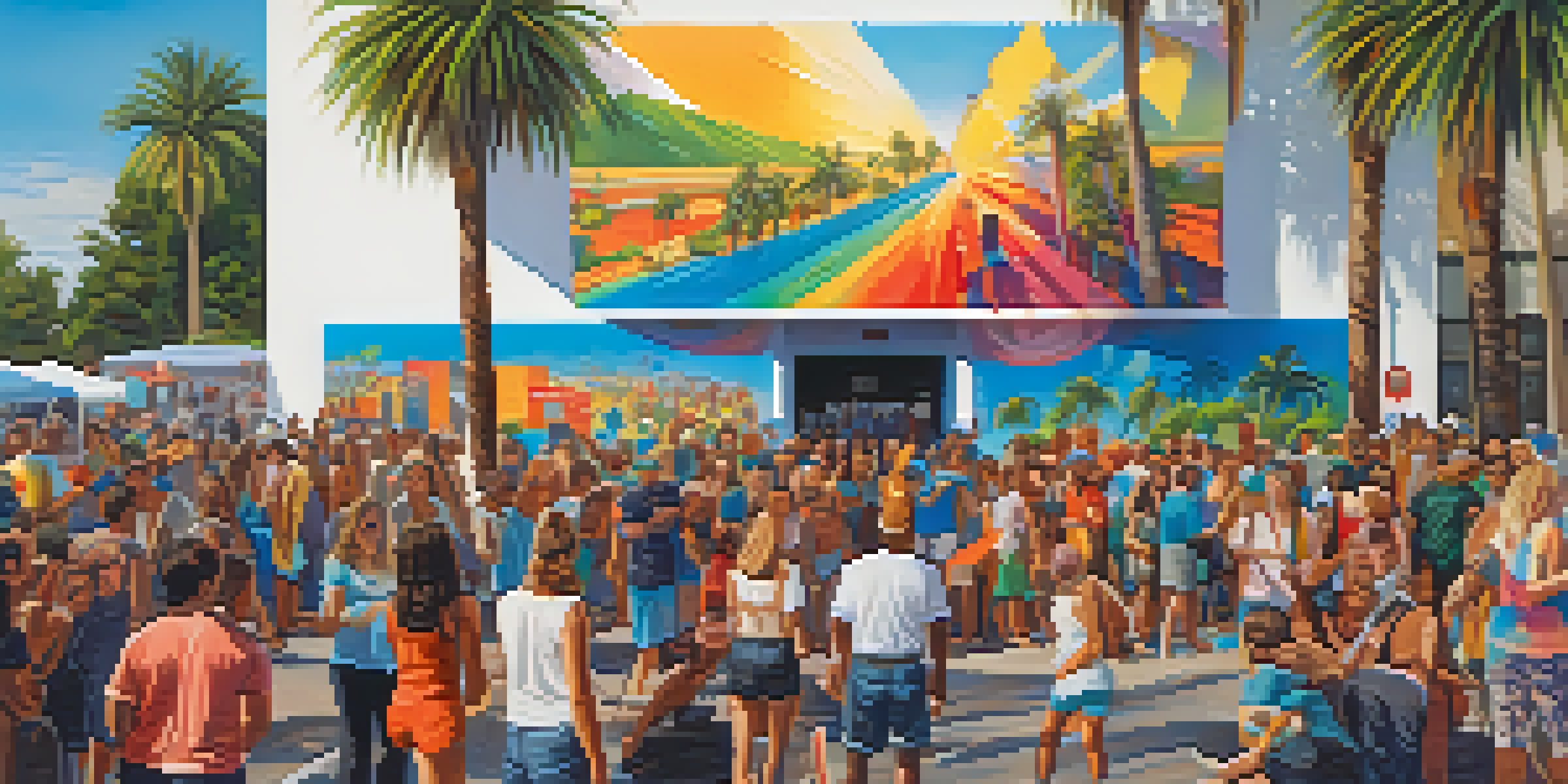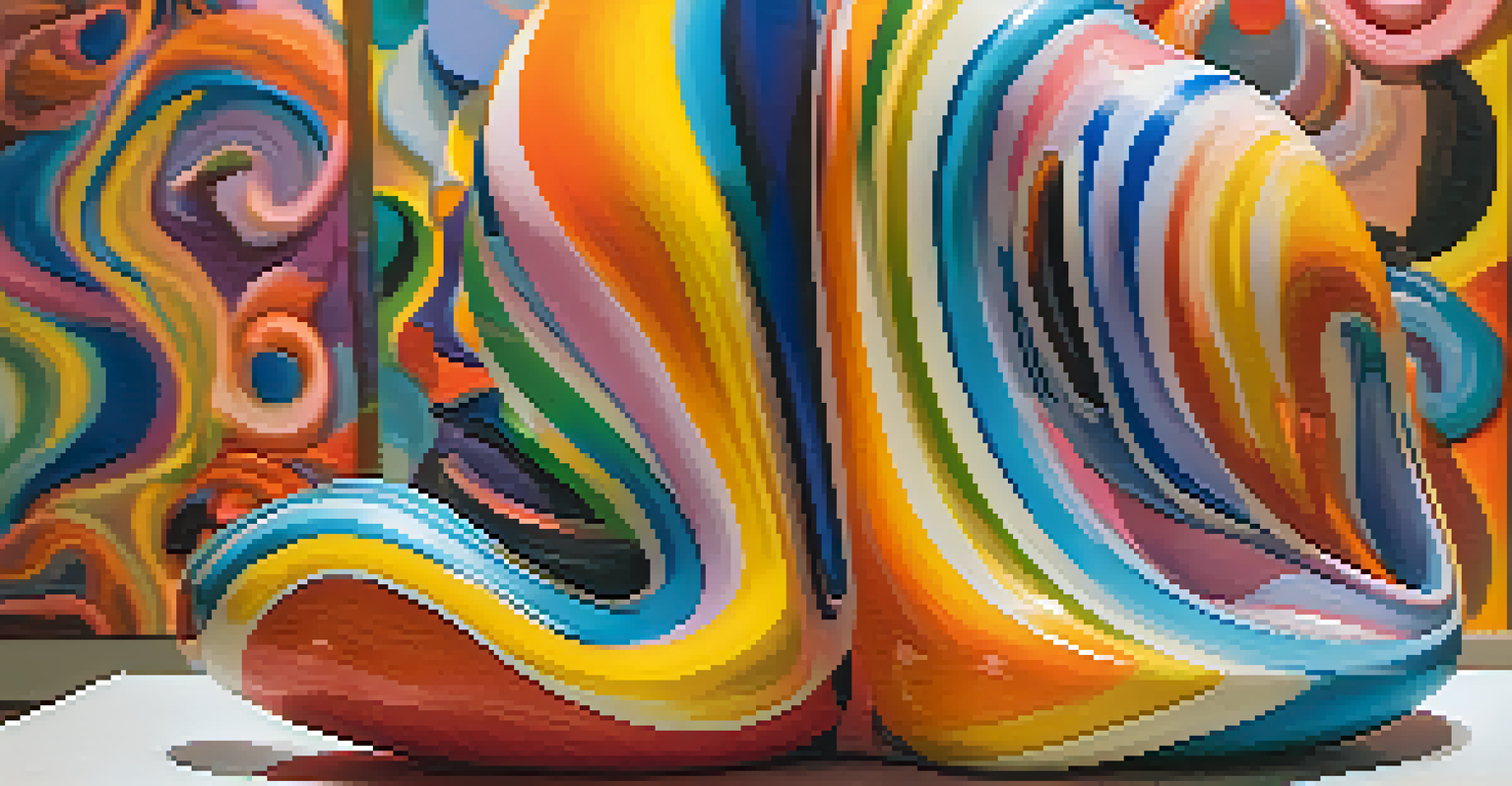California's Art Movements: The Role of Art Collectives

An Overview of California's Artistic Landscape
California has long been a crucible for artistic innovation, blending diverse cultures and experiences. From the beaches of Los Angeles to the vineyards of Napa, the state's art scene thrives on a rich tapestry of influences. This vibrant landscape has given rise to numerous art movements that reflect the spirit of California itself, characterized by experimentation and collaboration.
Art is not what you see, but what you make others see.
The unique geographical and cultural milieu of California has fostered an environment where artists feel free to explore new ideas. In cities like San Francisco, Los Angeles, and Oakland, art movements have emerged that challenge traditional forms and push the boundaries of creativity. As a result, California has produced a wealth of influential artists and collectives that have made their mark both nationally and internationally.
In this article, we will delve into the various art movements that have originated in California, highlighting the significant role that art collectives play in shaping these movements. By understanding this dynamic relationship, we can gain insight into how collaborative efforts continue to redefine the art scene in this diverse state.
The Birth of the California Art Collective
Art collectives have been a fundamental part of California's art history, with their roots traceable to the early 20th century. These groups often formed in response to societal changes, economic challenges, or the need for community among artists. They provided a platform for collaboration, allowing artists to share ideas, resources, and space, which was particularly crucial in a state as vast as California.

One of the earliest examples is the Group f.64, founded in 1932 by photographers in San Francisco. This collective sought to promote a new vision of photography that emphasized sharp focus and naturalistic imagery. Their innovative approaches not only influenced the art of photography but also set the stage for other collectives to emerge across various artistic disciplines.
California's Art Collectives Thrive
Art collectives in California have historically provided essential support for artists, fostering collaboration and creativity across various movements.
As we continue exploring California's art movements, it's essential to recognize how these collectives have served as incubators for creativity. By working together, artists can amplify their voices and foster a sense of belonging, contributing to a more vibrant and inclusive art scene.
The Funk Movement: A Playful Rebellion
The Funk Movement emerged in the 1960s in Northern California, characterized by its playful, irreverent approach to art. Artists associated with this movement sought to challenge established norms and conventions, often incorporating humor and whimsy into their work. This movement was a direct response to the seriousness of the art world, encouraging artists to embrace a more relaxed and experimental style.
Creativity takes courage.
Key figures of the Funk Movement, such as Robert Arneson and Viola Frey, used their art to comment on social issues while simultaneously engaging the viewer in a fun and accessible way. Their works often featured bold colors, exaggerated forms, and unconventional materials, making them stand out in an era dominated by minimalism and abstract expressionism. This fusion of humor and critique helped redefine what art could be.
Art collectives played a crucial role in the Funk Movement, providing a collaborative space where artists could experiment and share their ideas. These collectives encouraged a sense of community, allowing artists to support each other and push the boundaries of their craft, ultimately leading to a lasting impact on California's artistic identity.
The Chicano Art Movement: A Voice for the Community
Emerging in the 1970s, the Chicano Art Movement was a powerful expression of cultural identity and social justice. Artists within this movement sought to reclaim their history and represent the experiences of Mexican Americans in California and beyond. The movement was characterized by its vibrant imagery, often drawing on themes from indigenous culture, social struggle, and pride.
Art collectives like Los Four and the Royal Chicano Air Force were instrumental in amplifying the voices of Chicano artists. These groups not only provided a platform for collaboration but also organized exhibitions and events that brought attention to the issues affecting their communities. Through their art, they challenged stereotypes and advocated for civil rights, fostering a sense of unity and empowerment.
Funk Movement Redefines Art
The Funk Movement emerged as a playful rebellion against traditional art norms, encouraging artists to blend humor with social commentary.
Today, the legacy of the Chicano Art Movement continues to influence contemporary artists who draw inspiration from their cultural roots. The collective efforts of these artists have paved the way for future generations to express their identities and advocate for social change through art.
The Intersection of Technology and Art in California
As technology continues to evolve, so too does the landscape of art in California. The rise of digital media has opened up new avenues for artistic expression, allowing artists to experiment with innovative tools and platforms. Collectives like the Contemporary Jewish Museum's digital initiatives and the LA-based machine learning collective have harnessed technology to create interactive and immersive art experiences.
This intersection of technology and art has led to the emergence of new movements, such as New Media Art, which challenges traditional notions of what art can be. Artists are now able to create work that is not only visually striking but also incorporates sound, movement, and viewer interaction. This evolution has made art more accessible and engaging for a broader audience.
Art collectives in California have embraced these technological advancements, using them as a means to foster collaboration and experimentation. By bringing together artists with diverse skill sets and backgrounds, these collectives are pushing the boundaries of contemporary art, reshaping the way we experience creativity in the digital age.
The Role of Community in Art Collectives
At the heart of every successful art collective is a strong sense of community. These collectives provide a space for artists to connect, share ideas, and support each other in their creative endeavors. This communal aspect not only fosters collaboration but also helps to cultivate a nurturing environment where artists can thrive.
Many art collectives in California host workshops, exhibitions, and events that encourage community engagement and participation. These initiatives not only benefit the artists involved but also allow the public to connect with art on a deeper level. By bridging the gap between artists and the community, these collectives help to demystify the artistic process and make art more approachable.
Tech Shapes Modern Artistic Expression
The intersection of technology and art in California has led to new movements like New Media Art, expanding creative possibilities and audience engagement.
Ultimately, the role of community in art collectives cannot be overstated. By fostering connections among artists and the public, these groups are redefining the landscape of California's art scene, creating a more inclusive and vibrant cultural environment.
The Future of Art Collectives in California
As we look to the future, the role of art collectives in California's art scene is more important than ever. With the ongoing challenges posed by economic fluctuations and social changes, these collectives provide a vital support system for artists navigating the complexities of the art world. They foster resilience and adaptability, ensuring that creativity continues to flourish.
Emerging movements like eco-art and social practice art are gaining traction, further emphasizing the need for collaboration among artists. Collectives are increasingly focusing on projects that address environmental issues and social justice, reflecting the changing priorities of both artists and audiences. This shift highlights the power of art as a tool for activism and change.

Looking ahead, art collectives will continue to play a crucial role in shaping California's artistic identity. By embracing innovation, fostering community, and championing diverse voices, these groups will ensure that the state's art scene remains dynamic, relevant, and reflective of the rich tapestry of experiences that define California.